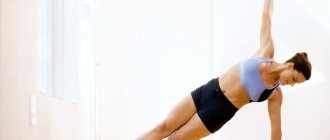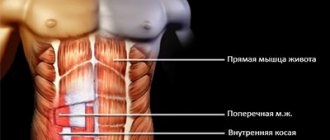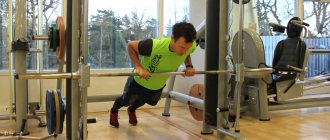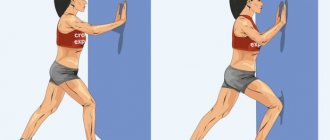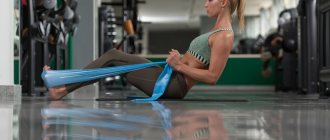Plank – an exercise to strengthen the abdominal muscles, the maximum effectiveness of which is achieved only if it is performed correctly. This article contains all the information that will help you understand the intricacies of performing this exercise. If you follow the rules and recommendations below, a positive result is guaranteed - a toned stomach and pumped up abs. All this can be achieved at home.
The most common mistake made by newcomers to the gym is sudden and excessive stress on the abdominal muscles, including classic or side crunches. Template exercises in this case are not at all important. To tone your abdominal muscles, you can work out new and innovative ways of training. In particular, the plank, the implementation of which allows you to strengthen the core muscles and form a strong muscle corsage.
It should be noted that this training method is not used in cases where the work is on relief. The reason is that the plank is aimed at strengthening and shaping, rather than pumping up muscles. In this regard, the exercise is most popular among those who seek to increase their levels of strength and endurance.
The plank is not an isolating exercise; its main goal is to strengthen the abdominal muscles; all abdominal sections are not pumped.
What is a plank?
The plank is a bodyweight exercise. It is also known as Kumbhakasana (in Sanskrit) and is part of one of the main complexes of yoga, the Sun complex. For a few minutes, you support your body on your toes and forearms while your head looks down (or to the side). This is a static exercise that does not require any equipment. Its effectiveness is enormous, which will be discussed in the next section.
How is exercise useful?
Doing this type of exercise regularly can benefit you in many ways. From helping you lose weight and get a flat and beautiful tummy to improving your mood. The following is a list of other benefits of the plank exercise for women:
- Improves posture. Planks strengthen your core and lower back muscles, thereby improving your posture.
- Reduces belly fat. A saggy belly is an obligatory gift that most of us receive due to bad habits. If you want to remove all those extra centimeters, then you just need a bar. By building and strengthening your core muscles, you can instantly strengthen your abs.
- Improves flexibility. Planks are great for improving flexibility.
- Reduces back pain. If you suffer from back pain, planking may be one of the solutions to get rid of it. Since this exercise targets the core and back muscles, it strengthens them, thereby reducing back pain.
- Improves mood. Doing planks will help improve your health and produce pleasure hormones. This is a great way to build confidence and do everything with enthusiasm.
- Builds endurance. The longer you can hold a plank, the better you will be at all other exercises. This is a proven fact.
Now you know why the plank is useful and why you should do it. Let's now find out what the technique is for performing the standard plank and its variations.
What muscles work?
The attractiveness of the plank, both for beginners and professional athletes, is due to the positive effect on the main muscle groups:
- The back muscles are subjected to significant strengthening loads, during which everything is worked out, from the cervical region to the deep back muscles.
- The arm muscles take on half the weight of your body and become stronger after each approach without changing their volume - the arms remain slender and graceful.
- Abdominal muscles - while doing the plank, you will more than once feel their treacherous trembling. The plank helps shape the abdominal contour and allows you to work out problem areas - the lateral and lower abdominal muscles.
- The leg muscles are where most of the weight of a novice athlete’s body falls. During an elbow stand, everything is tense - from the thighs to the calves.
- The gluteal muscles are the favorite part of the fair half of humanity. The elbow plank allows you to significantly strengthen the three paired muscles of the gluteal region - large, medium and small, and also helps get rid of cellulite in this traditionally difficult area of our body.
Interesting fact:
The elbow plank puts increased stress on the abdominal muscles and is a popular and reliable solution for creating sculpted abs.
General rules for performing the exercise
- Keep your shoulder blades retracted.
- Your buttocks and thighs should be in the same line.
- Keep your glutes and core engaged.
- Don't strain your neck. Keep it in a neutral position, looking down at the floor or up at the ceiling.
- Under no circumstances should you allow your lower back to sag too much.
While the plank is a great exercise, it may not be the best exercise for some of you. Find out if you should give it up completely.
Plank as a guarantee of health
It is a well-known fact that any trained muscle becomes stronger and stronger, and regular moderate loads on the body have a positive effect on a person’s well-being and increase life expectancy. The ease of performing the plank and the lack of need for sports equipment makes it an excellent option for morning exercises or warm-up during the working day. The benefits of elbow planks are due to their positive effect on the abdominal muscles. They are responsible for stabilizing and maintaining proper balance of the body. Insufficient loads lead to weakening of the abdominal muscles and progressive health problems, including improper functioning of internal organs, which this wonderful exercise helps to avoid.
We recommend watching a useful video on the technique of doing the elbow plank:
Who should not do the exercise?
If you have
- there was an operation
- pelvic pain
- I recently gave birth
- have a herniated disc
- weak bones
Remember that you should consult your trainer and doctor before performing any exercise.
Now you have all the information about the planks. There is no reason for you to stop anymore - set a goal, write it down and start doing the plank. You will see visible results within two weeks if you exercise correctly. Challenge yourself because physical fitness is just as important as intelligence. But remember that no matter how effective all types of planks are, the main thing is your motivation. Good luck!
Is it possible to pump up your abs with the plank exercise?
The plank position requires full tension and concentration of the abdominal muscles. Despite the fact that it is a static exercise, it is very helpful for working out a sculpted abdomen.
Every person has abdominal muscles, even those who are overweight or obese. The only thing is how far they are hidden under the folds of fat. And therefore, for such people you need to perform two tasks at once:
- Get rid of excess weight so that the abdominal muscles are visible;
- Work these same abdominal muscles.
And the bar successfully copes with both of them. Regular exercise will restore tone to your abdominal muscles. As a rule, weak tone of the abdominal muscles is the reason that the stomach “floats” forward - the muscles simply do not have enough strength to hold it.
The second thing I want to say is that holding the body in this position requires a large amount of strength. By maintaining tension in the press, you stimulate it to further grow and increase strength.
Execution technique
Now we will figure out how to do the plank exercise using the example of 2 classic execution techniques - on straight arms and on the elbows.
It’s very detailed and clear about the bar in the video – watch it!
Straight arm plank
Remember that correct technique is important. Further, having understood the nuances of the exercise, you will gradually be able to improve your time indicators. On the first day of classes, standing in the plank for 20 seconds will be enough for a beginner. Every day your result can be gradually improved. Then you will achieve the best results.
If you don’t have a mentor with you to check the correctness of the technique, then perform the exercise in front of a mirror. Also use a fitness mat.
- Take a lying position. From this position, rise up so that you are resting only on your palms and toes. The hands should be located exactly under the shoulders.
- Don't bend your legs, keep them straight
- The position of the back is absolutely straight. The shoulder blades are down. Don't round your back or stick out your tailbone. Gaze forward
- The abs must be kept at maximum tension and not relaxed until the end of the plank.
- The feet can be placed together, or they can be spread apart to shoulder width. The wider your feet are, the easier it is to perform the exercise, but you will reduce the efficiency of the muscles.
- Breathing – calm and continuous
Complicating the exercise
- Single leg plank. It is necessary to stand up, observing all the above rules and raise one leg up, keeping the body position static. After completing the exercise with one leg, repeat with the other. To maintain balance, you can place your hands slightly wider than your shoulders.
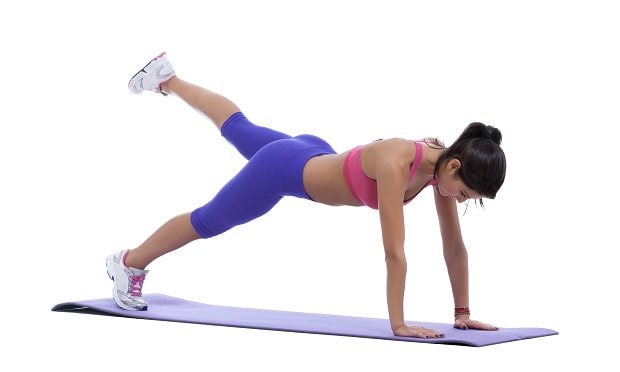
© Mihai Blanaru — stock.adobe.com
- Plank with arm extended. While standing in a plank position, extend one arm forward or hide it behind your back and maintain your balance, making sure to maintain a straight back line. Repeat the same steps with the other hand.
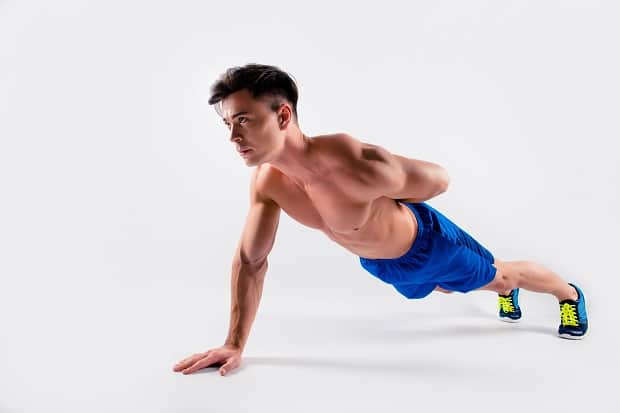
© deagreez — stock.adobe.com
Elbow plank
The principle of execution is the same as in the hand plank. The only difference is that you lean on your forearms. To do this, you need to bend your arms, keep your elbows strictly under your shoulders. Make sure that the spine does not bend, the tailbone does not protrude, and the abs remain tense.
Complicating the exercise
- On one leg. Leaning on your elbows, lift one leg up and stay in this position. Then repeat with the second leg.
- With an outstretched hand. While in an elbow plank, extend your arm forward. After standing motionless in this position for several seconds, change your hand.
- The hand and elbow planks can be combined into one exercise. First, take a position on straight arms, then lower yourself to your elbows, alternately bending first one arm, then the other. Then return to the starting position. Repeat several times.
Video with 5 unusual and effective plank variations, for those who confidently do the classic version of this exercise:
Benefits of the plank

Exercise helps develop a number of body characteristics, namely:
- strengthens and develops muscles;
- improves concentration;
- improves the waist.
Learn more about each benefit. The main effect of the exercise is aimed at the formation of rigid corset muscles, especially the abdominal and dorsal ones. If the plank is performed correctly, the neck muscles will also be activated, which will significantly improve your posture.
This method allows you to increase the endurance of the shoulder muscles, which is achieved by strengthening them during training. The plank also stimulates the development of the biceps, this is facilitated by the intense work of the biceps brachii muscle, which occurs when the upper section is held with outstretched arms. During the training, the pectoral, lower back, gluteal muscles, abs, and calves are strengthened.
From a psychological point of view, an important benefit is improved concentration, the importance of which cannot be underestimated. Performing the exercise requires concentration and concentration on the goal. This is also a good test of character - the body must be held taut like a string for a long time, which not everyone can do. At the same time, this is a great opportunity to work on yourself and strengthen your character, not to feel sorry for yourself and not to give up.
This exercise will be appreciated by those who have decided to start the fight against a sagging belly and a blurred waist. The plank will not only effectively eliminate these problems, but will also make your body more perfect with a toned waist and beautiful abs. However, you should not forget about a balanced diet and give up cardio training.
Plank 5-minute workout for weight loss
Plank exercise for 30 days or abs of steel in 30 days
This marathon program can truly do wonders for your body in just 30 days. The most important thing in this program is regularity. Set yourself a reminder on your smartphone or alarm clock and go ahead. In terms of time, this entire action takes no more than 5-10 minutes a day. This time is not difficult to find even for the busiest person.
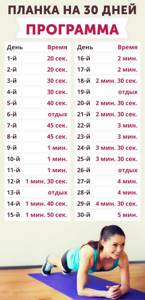
Ab plank
Planks are a type of exercise that everyone should do, not just those who want to build up their abs.
That's because the benefits of this exercise go much deeper than just six-pack abs.
Let's start with the obvious: planks are the best exercise for strengthening your core muscles.
Yes, they are even better than crunches.
Why? Because crunches don't actually work your core muscles.
You see, the core includes many more muscles, including those that form your six-pack. They occupy the entire front of the abdomen and lower back.
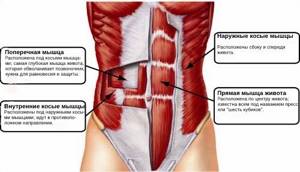
Core muscles
These include the rectus abdominis (6-pack abs), internal and external obliques (muscles that run down the sides of the torso), transverse abdominis (the innermost layer of muscle around the spine), hip muscles, and lower back muscles.
Crunches bypass most of these muscles and focus only on the rectus abdominis (6-pack). With their help, you can pump up your abdominal muscles, but your core muscles will remain invariably weak.
Planks, on the other hand, work not only the abdominal muscles, but also all the other abdominal muscles.
This leads to the so-called “corset” effect, in which the internal core muscles envelop the torso in a tight corset.
Still in doubt? Research shows that crunches work less core muscle than exercises that work the deltoids and glutes, such as planks.
And now we come to the next reason why you need to make planks:
Seven main types of planks
Different variations of the exercise can be useful as endurance increases, when the standard stance will not cause problems and the feeling of discomfort will disappear.
Elbow stand

Taking a lying position (stomach down), stand on your elbows. Then raise your body so that you mentally form a straight line. It is important not to let your butt sag or protrude. Maintain this position for the maximum amount of time, while recording all the results and increasing the duration of each workout (at the initial stage, the difference may be several seconds).
Side stand

It is performed according to the same principle as on the elbows, only the body turns sideways and the emphasis is transferred to only one hand. Exercises are performed on each hand in turn. The requirements are standard: a straight line of the body without sagging or protruding parts.
Footstand

Take the starting position and raise your leg. Maintain your body in this position for the maximum amount of time.
Arm stand

Take the starting position - a regular plank. Raise your arm and straighten it so that it is parallel to your body. Hold this position for some time, then return to the classic stance and repeat everything, but with the other hand. This counts as one repetition.
Stand with transition

Lie on the floor, raise your body, as if doing a classic plank. Then move to a side stance, after 10 seconds turn to the other side. The holding time on each side is the same - 10 seconds. Take the starting position. This counts as one repetition. That is, the classic stance alternates with the side one without rest.
Side stand with a turn

Take the same position as when performing a side plank. The emphasis is placed on one arm, the second is raised up above the body and straightened so that it is perpendicular to the floor. Lower your hand, touching the floor and raise it to the starting position. Do 10 times, then switch to the other side and repeat again.
Stand with fitball

For this exercise you will need a bench. Place your feet on the bench, forearms on the ball. When performing the stance correctly, the body forms a straight line from the shoulders to the ankles. Hold your body in this stance for a minute.
You can move on to the listed variations of the plank after you notice an increase in endurance when performing the classical technique. It is important to remember that such exercises increase blood pressure, so they are contraindicated for people with health problems.
How NOT to do a plank
Common mistakes when performing the plank exercise are lifting your buttocks too high, as well as placing excess stress on your shoulders and wrists. The correct technique involves a slight “twisting” of the pelvis, in which the tailbone is directed back - this transfers the load from the lower back and back to the abdominal muscles.
At the same time, the gaze is directed in front of you, the neck does not bend upward. It is also important to press your shoulders as tightly as possible to your body, engaging the muscles of the upper back and pectoral muscles - the spine is straight, the chest is open and looks forward rather than down.
If you're a beginner doing an extended-arm plank, also pay attention to distributing the weight evenly across the entire surface of your palm and not just pressing down on your wrist.
Contraindications
If you have back pain, perform planks under the supervision of a personal trainer who can correct your technique. Additional care when performing the plank will be required for those who have had injuries to the spine, shoulder or elbow joints, or wrists.
***
A toned and sculpted abdomen requires both the development of the rectus abdominis muscle through crunches and other dynamic abdominal exercises, and the development of the internal abdominal muscles with stationary (static) exercises. The best such exercise is the plank. However, the correct technique for performing the plank plays a decisive role in achieving results.
Planks for beginners
Above we looked at the correct position for performing a standard plank. But what if you've never done a plank?
One of the reasons why this exercise is so effective for the abs is its versatility. It is suitable for girls and effective for men. Let's look at the different types of planks below. They will help you achieve the full plank:
Plank abdominal exercise on knees
- Place a mat or towel under your knees before getting down on all fours.
- Take a plank position with your arms outstretched, placing them strictly under your shoulders.
- Include your stomach and buttocks in the exercise and hold the pose for 15-30 seconds.
- Perform three sets of 15-30 seconds each.
High Plank (Push-Up Position)
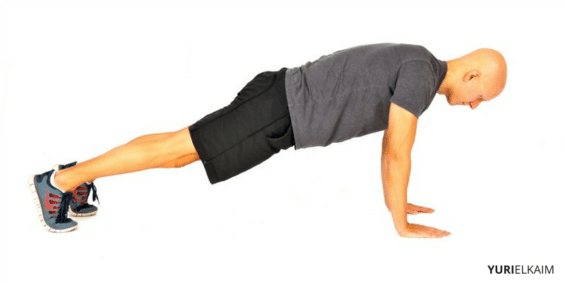
- Get into a push-up position with your hands under your shoulders. The body should be straight from head to toe.
- Engage your buttocks, keep your arms straight, hold the pose for 15 - 30 seconds.
- Perform 3 sets of 15 - 30 seconds each.
- If you can hold the plank on your outstretched arms for more than 30 seconds, switch to a standard plank on your elbows.
At this stage, you can try side planks for variety.
Side plank

- Start in a standard plank position with your elbows level with your shoulders.
- Roll onto your side and lift your free arm up, opening your chest.
- Your hips should be in the air with one leg on top of the other.
- Hold the position for 15-30 seconds, then switch sides. Perform 3 sets.
Plank exercise: benefits and harms
Benefit
Basically, all the exercises done in training are dynamic. They are aimed at working one muscle group. The static load when performing the plank exercise acts on a muscle group and amazes with its results. Within just a few weeks, you can notice a change in your figure for the better. By doing this exercise it is possible to lose weight, as daily exercise increases metabolism. The plank can be part of a regular dynamic workout and can perfectly complement it.
Harm
For people suffering from unstable blood pressure and diseases of the cardiovascular system, this exercise is not recommended, since the pressure may rise during the exercise. For girls, a contraindication to performing this exercise is the period of PMS and pregnancy.
Monthly training plan

Whether it is possible to remove fat with the help of a plank depends on the training plan, as well as the athlete’s nutrition.
The training program for both women and men should contain exercises for the abdomen and sides, take into account how many times a day and week they need to be performed, and calculate the workouts for at least 30 days.
A monthly training plan might look something like this:
| Day | Training |
| Day 1-7 | Warm up, then standard plank. 3-5 approaches to the maximum, depending on the level of fatigue. It will get better every day. |
| Day 8-15 | Warm up, then 3 sets of regular plank, 3 sets of reverse plank. |
| Day 16-24 | Warm up: 3 sets of regular plank, then 3 sets of side plank and 3 sets of reverse plank. |
| Day 25-30 | If you can hold the plank for more than two minutes each approach, you can add additional weights. It is better to start with a minimum weight of a couple of kilograms, then gradually increase it. |
The presented plan is approximate. There are many approaches and techniques, each of which has its own characteristics.

